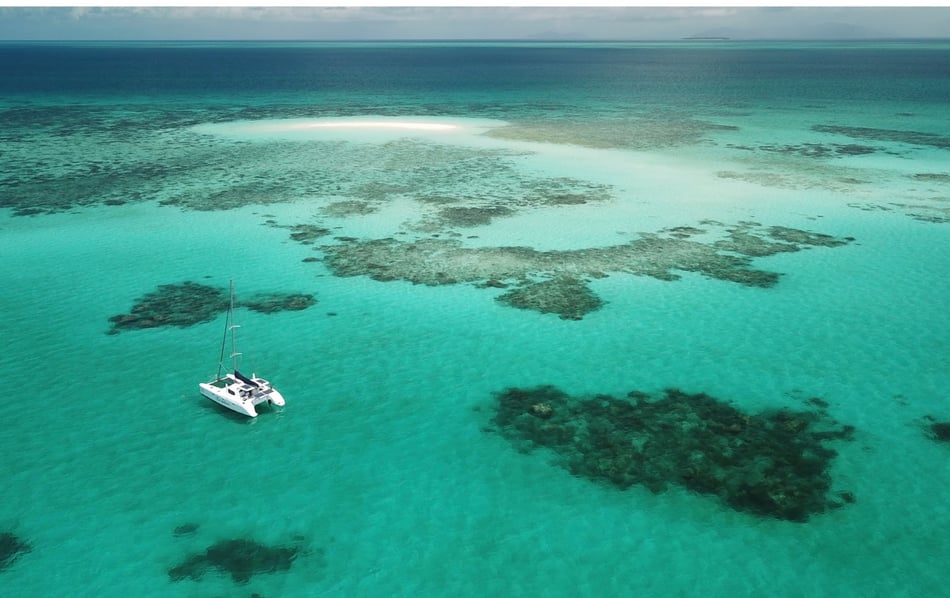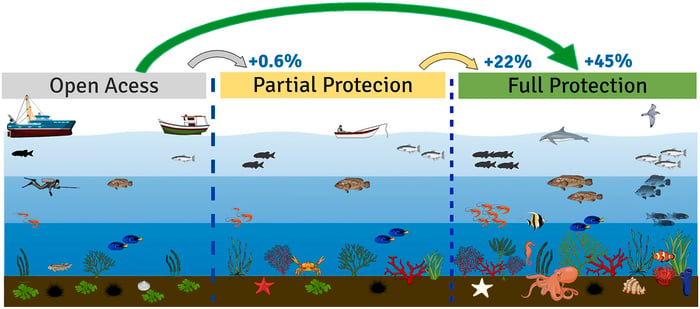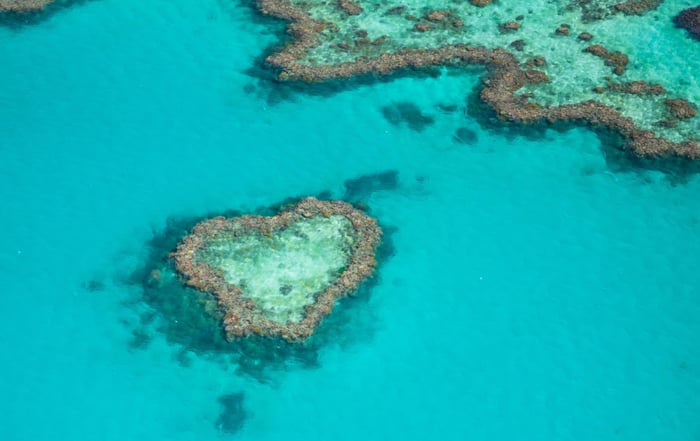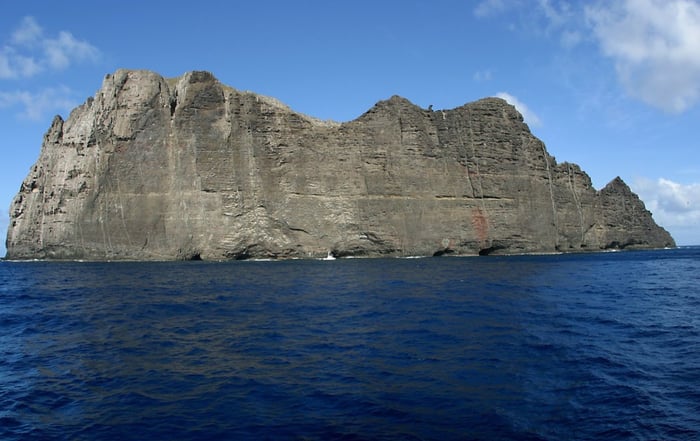Anchoring Our Future: The Importance of Marine Protected Areas

Tin
4
min. read

The oceans are the lifeblood of our planet, covering over 70% of the Earth's surface and playing a crucial role in regulating our climate.
They are not only home to an incredible diversity of marine life but also provide sustenance and livelihoods for millions of people around the world. Moreover, the oceans are the Earth's largest carbon sink, absorbing and storing vast amounts of carbon dioxide, making their health vital in the fight against climate change.
One of the proactive measures we are taking to safeguard these habitats is through the establishment of Marine Protected Areas.
They are not only home to an incredible diversity of marine life but also provide sustenance and livelihoods for millions of people around the world. Moreover, the oceans are the Earth's largest carbon sink, absorbing and storing vast amounts of carbon dioxide, making their health vital in the fight against climate change.
One of the proactive measures we are taking to safeguard these habitats is through the establishment of Marine Protected Areas.
What are Marine Protected Areas?

Graphic taken from Ferreira et. al., (2022)’s study on the drivers of ecological effectiveness of marine protected areas
Marine Protected Areas (known shorthand as MPAs) can be likened to the national parks of our oceans. These designated zones are primarily aimed at conserving marine ecosystems, preserving biodiversity, and fostering sustainable marine resource use.
There are various types of MPAs, each with a distinct purpose; for example, no-take zones are stringent in protection, prohibiting all extractive activities like fishing but people may still access them for recreational purposes like snorkeling. In contrast, multiple-use areas allow specific activities like minimal fishing under regulated conditions, emphasizing both conservation and sustainable use.
As per data from the Marine Conservation Institute, approximately 8% of the Earth's oceans are designated under some form of marine protection. However, as of May 2023 data shows that only 2.9% of these marine areas meet the institute's criteria for being classified as 'fully or highly protected' zones.
Currently, there is a worldwide initiative to instill 30% of the earth’s land and ocean resources as protected areas. The objective was put forth in a 2019 article published in Science Advances titled "A Global Deal for Nature: Guiding principles, milestones, and targets," emphasizing the imperative for an increased focus on nature conservation.
Why are MPAs Important?
MPAs are more than just oceanic sanctuaries; they are crucial pillars in maintaining the health of our planet. Below are just some of the many benefits that these crucial protected areas provide.

Protecting Biodiversity
MPAs are integral for marine conservation, serving as refuges for various marine species and habitats. They ensure ecosystems remain balanced and vibrant by minimizing disturbances.
Economic Benefits
MPAs have been shown to directly bolster fisheries sustainability. They protect breeding grounds and allow marine species to mature and reproduce, increasing the pool of resources we can fish from. This protection also leads to spill-over effects benefiting surrounding fishing areas. Furthermore, the appeal of untouched marine landscapes and diverse marine life can significantly enhance local tourism, driving economic benefits.
Ecological Benefits
The ocean comprises a mosaic of ecosystems. These aren't just biodiversity reservoirs; for instance, coral reefs act as natural breakwaters, mangroves are critical for coastline stabilization, and seagrass beds are nurseries for young marine species.
Climate Regulation
Oceans are our biggest carbon sink, sequestering a massive chunk of CO2 emissions. Specifically, ecosystems like mangroves and seagrass meadows are astoundingly effective at carbon storage, thus helping in global climate regulation. Through MPAs, these carbon-rich habitats remain preserved, playing a part in the worldwide effort against escalating atmospheric carbon.
The Triumph of Marine Protected Areas
When it comes to conserving our oceans, MPAs have proven to be unparalleled success stories. By safeguarding marine life, supporting local communities, and rejuvenating economies, these sanctuaries have demonstrated tangible results in ways that most, if not all, other conservation initiatives have not.
One such example of this is the Great Barrier Reef Marine Park in Australia. Spanning over 344,400 square kilometers, this MPA doesn't just protect the world's largest coral reef system but also ensures the livelihood of the communities relying on it. However, preservation in the GBR Marine Park isn't just about marine life: it's also a boon for the economy. Tourism to the reef generates AUD 6.4 billion annually, supporting the creation of full-time jobs and one of the largest eco-tourism economies in the world.

Another shining example of protected areas succeeding in the sea is the Papahānaumokuākea Marine National Monument in Hawaii. This vast MPA, stretching across 582,578 square miles, is a haven for over 7,000 species, a quarter of which are unique to the Hawaiian Archipelago. Beyond biodiversity, it's a sacred space for Native Hawaiians, anchoring cultural practices and beliefs. Its designation has been a catalyst for scientific research, eco-tourism, and cultural resurgence, marrying conservation with community empowerment.

Marine Protected Areas: Our Pledge to the Oceans
MPAs stand as a powerful testament to humanity's ability to heal and safeguard our oceans. However, our work is far from done. To secure the future of our oceans, it's imperative that we continue to expand and effectively manage MPAs, engage in sustainable fishing practices, and raise awareness about the significance of these protected areas. By doing so, we can ensure that the wonders of the sea endure for generations to come, providing a lasting legacy of conservation and preservation for our planet.
Much like marine protected areas shelter and nurture marine life, IMARCS strives to create a world where the oceans' riches are cherished, safeguarded, and shared equitably among all. Join us in our journey toward a more resilient, vibrant, and prosperous marine world, where every corner of the ocean finds its sanctuary.
Together we can make a real, positive, and measurable impact on our beloved planet.
References:
30 by 30: why humanity should protect 30 per cent of the ocean by 2030. (2021, June 1). New Scientist (1971). https://www.newscientist.com/article/2279097-30-by-30-why-humanity-should-protect-30-per-cent-of-the-ocean-by-2030/
Algae vs seagrass. (n.d.). Smithsonian Ocean. Retrieved September 7, 2023, from https://ocean.si.edu/holding-tank/images-hide/algae-vs-seagrass
Alongi, D. M. (2012). Carbon sequestration in mangrove forests. Carbon Management, 3(3), 313–322. https://doi.org/10.4155/cmt.12.20
Davis, K. J., Vianna, G. M. S., Meeuwig, J. J., Meekan, M. G., & Pannell, D. J. (2019). Estimating the economic benefits and costs of highly‐protected marine protected areas. Ecosphere (Washington, D.C), 10(10). https://doi.org/10.1002/ecs2.2879
Papahānaumokuākea marine national monument. (2018, September 25). NOAA Fisheries. https://www.fisheries.noaa.gov/pacific-islands/habitat-conservation/papahanaumokuakea-marine-national-monument
Reef Facts. (2022, August 22). Australian Government. https://www2.gbrmpa.gov.au/learn/reef-facts#:~:text=The%20Great%20Barrier%20Reef%20is,around%2064%2C000%20full%2Dtime%20jobs.
Sarker, S., & Mahmudul Islam, M. (2021). Marine protected area and biodiversity conservation. In Encyclopedia of the UN Sustainable Development Goals (pp. 1–15). Springer International Publishing.
Types and design of marine protected areas. (n.d.). Oceantracks.org. Retrieved September 7, 2023, from https://oceantracks.org/library/conservation/types-and-design-of-marine-protected-areas
United Nations. (n.d.). The ocean – the world’s greatest ally against climate change | United Nations. Retrieved September 7, 2023, from https://www.un.org/en/climatechange/science/climate-issues/ocean
US Environmental Protection Agency. (2022). EPA scientists study the carbon-storing power of seagrass to fight climate change. https://www.epa.gov/sciencematters/epa-scientists-study-carbon-storing-power-seagrass-fight-climate-change
What is sustainable seafood? (n.d.). Seafoodwatch.org. Retrieved September 7, 2023, from https://www.seafoodwatch.org/seafood-basics/what-is-sustainable-seafood